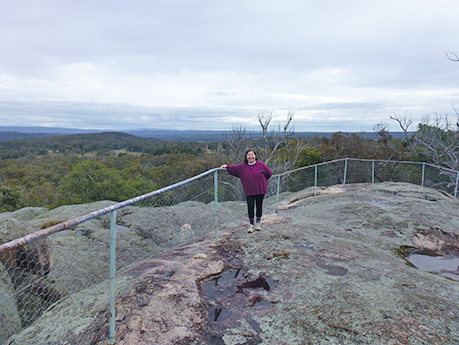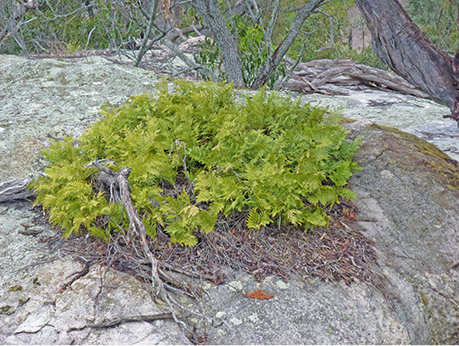Plus a small section on Donelly's Castle
This 24th edition, 2014-15, of the Southern Downs Pocket Book covers the years 2014 and 2015. Both years are momentous hundredth anniversary years for Australia and for the Granite Belt region of Queensland. On 28th of June 1914, the Archduke Franz Ferdinand was assassinated in Bosnia, leading to the First World War. The Archduke was heir to the Austrian-Hungarian throne. With the backing of Germany and later Turkey, on 28th July 1914, Austria-Hungary declared war on Serbia to avenge the murder. A complex set of alliances led to the start of this European war, eventually involving other continents to become World War One.
Australia's involvement started on 5th August 1914, the day after the English declaration of war on Germany, when the artillery battery at Fort Nepean in Victoria put a shot, the first for the Empire, over the bow of the 6,557 ton German cargo ship, SS Pfalz, as it was about to leave Port Phillip Bay, capturing the first enemy of the war.
German New Guinea was the next target. One story says that four Queensland police walked across from the Queensland colony of Papua and arrested the five German infantry guarding the German colony of New Guinea, taking the whole German colony in the process. But more likely is that Australian army troops captured the German force led by captain Carl von Klewitz; the first Allied victory of World War One. In the biggest battle, on the 11th September 1914, the Australian naval and infantry forces attacked the wireless station at Bita Paka, near Rabaul, in New Pommern, later New Britain, suffering six dead and four wounded, while a German officer and 30 native police were killed and a German and ten natives were wounded. New Guinea and the Bismark Archipelago had been the first part of the short-lived German Empire, being occupied by them in 1884.
Of course, the real Australian activity started on 25th April 1915 with the invasion of Gallipoli, a small beach in the Dardenelles region of Turkey. This is the next important centenary. Sitting back at Kew Vic's Burke Hall school in 1960, our grade three teacher, Pop Irish, would tell of his landing at Gallipoli, and tell the older boys at the school, just quietly, how his own brother was shot up on the boat in the place next to him.
The Australian forces went on to be the Allies' spearhead troops, under Australia's General Monash, throughout the western front in France. General Monash was an engineer (I assume like Campbell Newman) who redesigned the principle of the tank. His tanks could do the work required and, travel at speed! Monash University is named after him.
Warwick, Stanthorpe, and whole Southern Darling Downs, contributed men and supplies to the war effort. The RSLs are the living testament to the memory of these men and women and their families.
On returning to Australia, many troops were offered Soldier Settlement land on which to establish farms and lifestyles. One of these major areas in Queensland are the settlements north and west of Stanthorpe. French battlefield names became the quiet Granite Belt villages, hamlets and localities of Amiens, Bapaume, Pozieres, Fleurbaix, Passchendaele, Somme, Ballandean & Severnlea. These mixed with the more British names of Fletcher, Glen Aplin, Thorndale, Broadwater, Greenlands, Cannon Creek, Applethorpe, Cottonvale, Thulimbah, Palgrave and Goldfields. See maps M & R.
Other first world war soldier settlements included Mount Gravatt, Enoggera, Woombye and Bald Hills.
The settlements near Stanthorpe had the advantage of a cool dry climate, which was valued in the early nineteenth century as an aid to health; especially as an aid to those suffering from tuberculosis and chest conditions, and those soldiers recovering from mustard gas exposure.

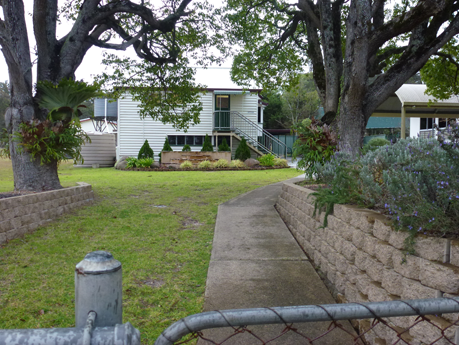
Pozieres State School (above):
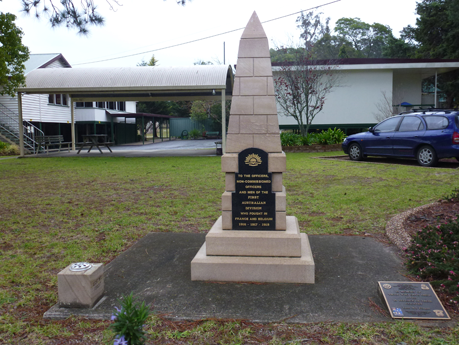
Pozieres State School Cenataph (above):
"To the officers, non-commissioned officers and men of the First Australian Division who fought in France and Belgium 1916 - 1917 - 1918."
The side plaque states "In Memory of Those Who Gave Their Lives in Defence of Their Country. Lest We Forget." Project Sponsors: Department of Veterans Affairs, Anzac Day Commemoration Committee, Stanthorpe R.S.L, Stanthorpe Shire Council, Pozieres C.C. P & C Assoc. The plaque includes shields for "Their Service Our Heritage", "Anzac Day Commemoration Committee (Qld) Inc.", "Returned & Services league Australia", "Pozieres State School". This memorial was designed and constructed by the Pozieres School Community 1999."
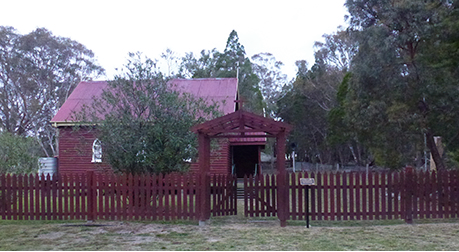
St Denys', the Anglican Church at Amiens, was completed in 1923 by the Rev C D Gillman, a returned soldier, and Cannon Garland, member of the Church of England Soldier Help Society. It is named after the patron saint of France with altar ornaments, including the candlesticks, being a gift from the Amiens Catholic Cathedral in France, having previously been used in the small chapel at the Australian military base at LeHarve, where many Australian soldiers prayed before battle.
The Catholic Basilica of Our lady of Amiens was built from 1220 to 1270 and is 19th largest church in the World and the highest, at 42.3m, in France attempting to reach the heavens. Amiens is 120 km north of Paris.
St. Denys (also known as St. Denis) is the patron saint of France, where he preached the Gospel and in whose capital city he suffered martyrdom. Denys was born and raised in Italy. Pope St. Clement sent Denys as a missionary to France. He made his base of missionary activity on an island (Ile de la Cite) in the Seine near the city of Lutetia Parisorium, which eventually became the city of Paris. His number of conversions led to his arrest and he was executed, martyred, by beheading.
The legend of St. Denys expressly states that after he was beheaded in AD 272 he rose and carried his head off in his hand to the summit of Mont Mars (now Montmartre), the angels singing hymns along the way, where he was buried. Along with many other tourists, Nevenka, our son Gerard, and I have visited the artists fair at modern Montmartre; and the Jesuits have their headquarters there. Our son, Gerard, has also played trumpet at many Anzac ceremonies, in his school days.
When King Dagobert I (reign 628-637) moved his relics to the famous Abbey of St. Denys, founded by him in Denys honour, the saint became the patron of the French monarchy and his name the battle-cry of the French armies. The sacred banner of France had its origin in being consecrated on his tomb. In 1144 portions were added and rebuilt, becoming the Cathedral Basilica of St Denys. Most French kings from 10th till the 18th century are buried there.
In 1923, Rev Gillman and Cannon Garland, through their church, connected this soldier settlement with the battlefields and these two mighty basilicas. Thus, they successfully and thoughtfully included the ecumenical denomination aspect with the fates of the Australian men, women and their families.
Fr Greg Windsor, rector at Stanthorpe Anglican parish looks after the six churches of St Barnabas at Dalveen, St John at the Summit, St James at Glen Aplin, St Johns at Liston, St Paul's at Stanthorpe and St Denys' at Amiens. All have regular services with St Denys' each third Sunday at 7:30am, except Jan, and a special Commemorative Day on the third Sunday in November starting at 8am.
There are two categories of saints: martyrs and confessors. A Christian martyr is regarded as one who is put to death for his Christian faith or convictions. Confessors are esteemed holy persons who've died natural deaths. Saint Denys is the patron saint of France and also, of Headaches. France, where he preached the gospel; and headaches, due to his form of death.
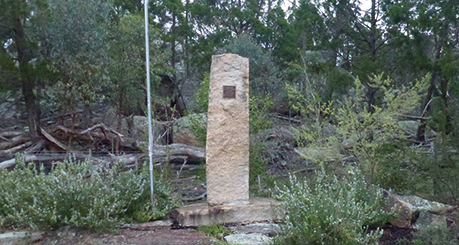
Within the Denys' Church grounds is an extra monument signifying how the war affected not just the soldiers, but wider community. The plaque reads "This memorial garden was dedicated on 21st December 2008 with gratitude to all those men and women affected by the conflict of the 1914 - 1918 war." This is an apt ode by a church of God as war affects far more than the men.

Still at Amiens, near the general store, is this mosaic monument to Simpson and his donkey. Jack Simpson Kirkpatrick was born in 1892 at South Shields in the north east of England. As a child in Shields he worked as a donkey-lad. In August 1914 he joined the Australian army in Perth, but as Jack Simpson.
He landed at Galliopoli on the first day on 25th April 1915, as a field ambulance stretcher bearer. The very next day he came across a donkey. During the next three weeks Simpson and his donkey rescued over 300 men, until he was shot in the back. Despite his commanding officer, the later great, General Monash, recommending that he receive a Victoria Cross, neither the Australian Government nor the British Government has yet awarded it. These governments produce a never ending hurdle of redtape, which I am sure Ian Macfarlane and Bruce Scott could just sweep away, if they read this article!
The Story of the Settlements
There were seven main soldier settlements in the Stanthorpe area - Broadwater, Drumsleed, Folkestone, Marsh, Nundubbermere, Pikedale and Stanthorpe. These government names include with them the more familiar settlement names like Pozieres and Amiens.
The scope of the work can be seen from the figures of the one settlement area of Pikedale. In 1916, long before the end of the war, £100,000 was allocated for the Pikedale Soldier Settlement Scheme. Seventeen thousand, four hundred acres was set aside for Returned Servicemen which would become known as the areas of Cottonvale, Fleurbaix, Pozieres, Bullecourt, Passchendaele, Bapaume, Messines and Amiens. Eventually 105 families would settle here.
At Amiens, the government's "Settlement Experimental farm" supplied training, and the government built, or assisted in the business development of, post office, school, store, bakery, butchery, sawmill, cannery & sauce factory. Mr. A. P. Devereux, formerly an orchardist at Huon Tasmania, was in charge of the experimental farm.
The first Bush Nurse was headquartered at Amiens. Soon followed the building of churches, the Druids Hall, memorial Hall, library, green grocer, hairdresser, tin-smith, plumber, pie shop and haberdashery.
The government farm was planted with deciduous fruits, vegetables, potatoes, corn, while other activities included pig and poultry raising.
Settlers received a government loan of £650 for land, clearing of five acres, horse with cart, tools, housing and farm establishment costs.
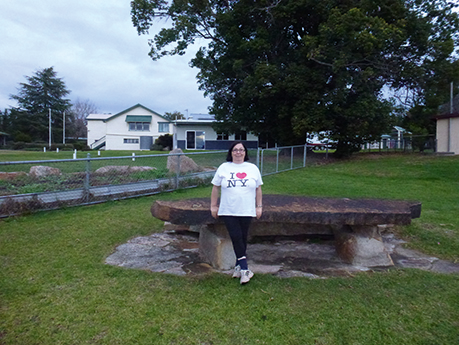
Many now enjoy the picnic amongst the history at the stone table.
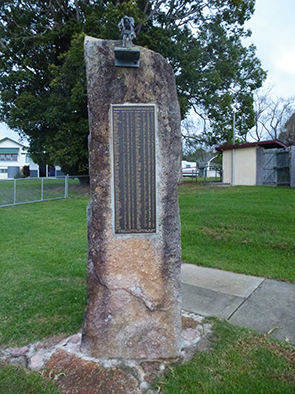
The main monument is to the "Families on Soldier Settlement Blocks 1922" with a list of the names of the returnees and their lot numbers. 1922 was four years after the main war and would have been sufficient time for those would take up the blocks and to already be fairly well established.
The place names and localities are different to the government parish names, but the settlers titles are given as a lot number within a government "parish". This is not a church parish.
The Parish names:
B - Broadwater with 9 settlers
D - Drumsleed with 6 settlers
F - Folkestone with 19 settlers
M - Marsh with 157 settlers
N - Nundubbermere with 41 settlers
P - Pikedale with 105 settlers
S - Stanthorpe with 10 settlers
There are 3 unallocated settlers, probably because of incomplete records.
This makes a total of 340 settlers. This is the list from the monument:
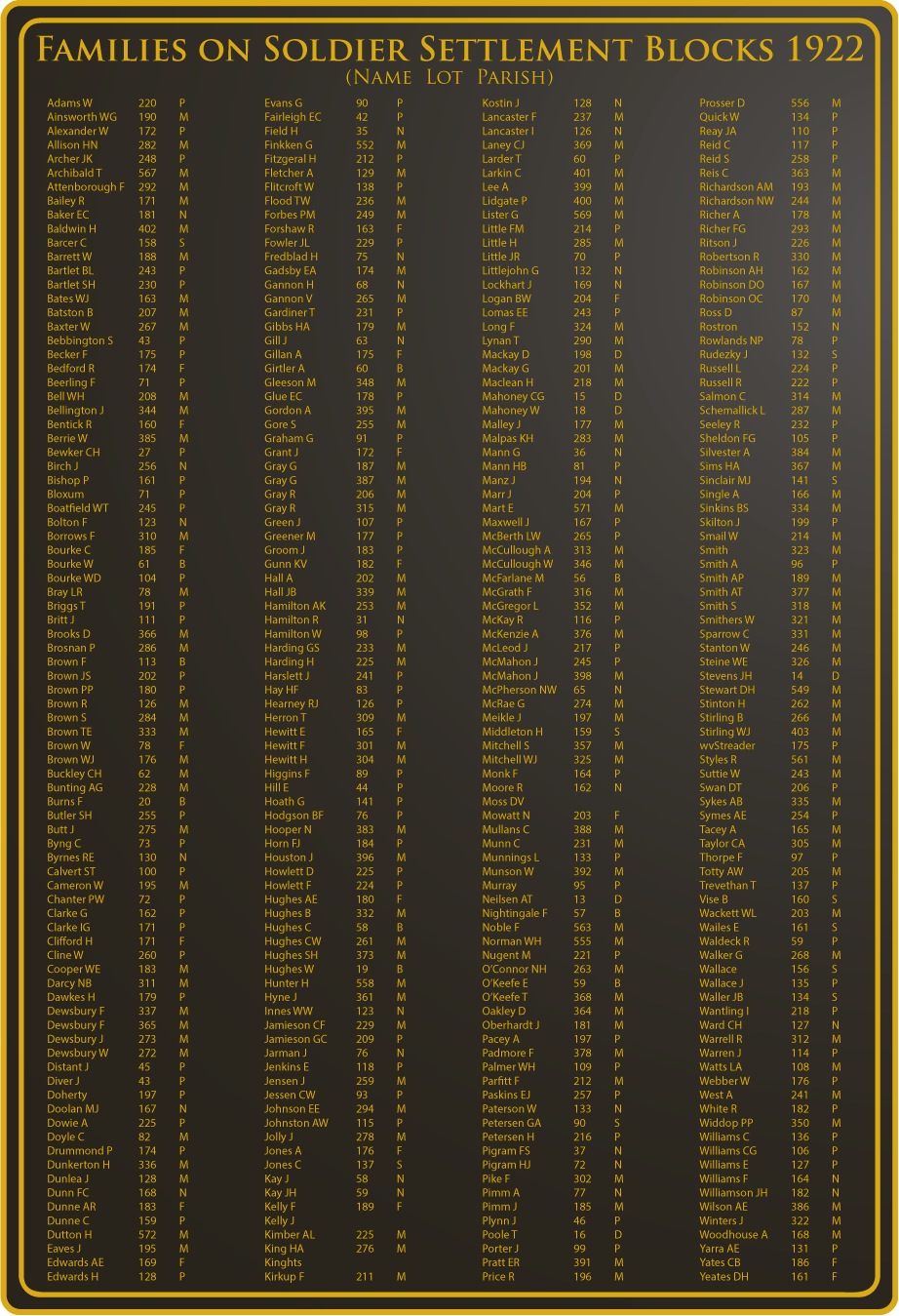
The story of these settlers is told by Jean Harslett, a daughter in-law of a Pikedale settler, and Meryn Royle, in their book They came to a plateau (the Stanthorpe saga).
Donelly's Castle Recreation Reserve
Within the general soldier settlement area at Pozieres, on Map M D6, is the Donelly's Castle Recreation Reserve. This is used as for general holiday camping and as an educational area.
The original 3.6 ha, or 9 acres, of the land forming this reserve was named Donelly's Castle after Edward (Ned) Donelly who was an original settler of the area. The late Pietro Zanatta donated a further 4.8 ha, or 12 acres, in 1941 which was included to form this into a Crown Recreation Reserve. In 1973 the Lions Club of Stanthorpe started devlopment of of the area for the public use. The area has bar-be-ques for wood (ie not electric), tables, picnic facilities and a toilet.
In the late 1800's, an outlaw bushranger, nicknamed Thunderbolt, is rumoured to have lived in the semi-cave and area. Frederick Wordswoth Ward, born in 1835 to Michael & Sofia Ward, was one of their ten children. In 1856 he was convicted, with some cousins, of horse stealing and sent to jail. On 11 Sept 1863, Fred had escaped from Cockatoo Island, the penal prison in Sydney. After six years of creating havoc with robberies, living in many different caves through northern NSW and southern Queensland, and being involved with several skirmishes with the police where accomplices would be captured, Ward was eventally shot dead by Constable Walker on 25th May 1870 at Kentucky Creek near Uralla. Even though these bushrangers sometimes have a larger-then-deserved reputation, the local townsfolk, in 1863, were very relieved to see the end of this thief, and raised a small bursury for Walker, in appreciation of his work.
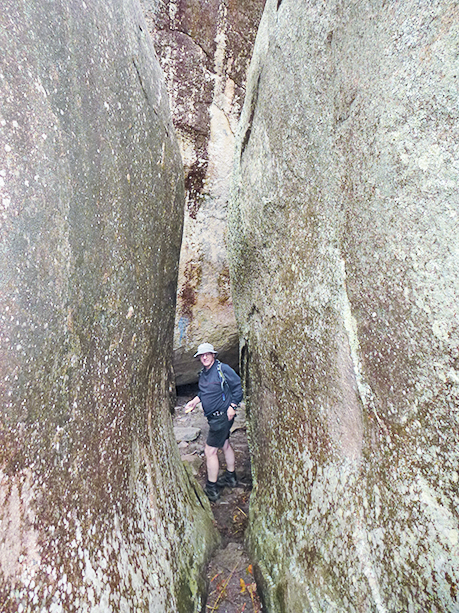
Gerry Clarke entering Donelly's cave.
"Yowies have been hanging out here for centuries;" well, some the artwork from the lads might be around for a few years.
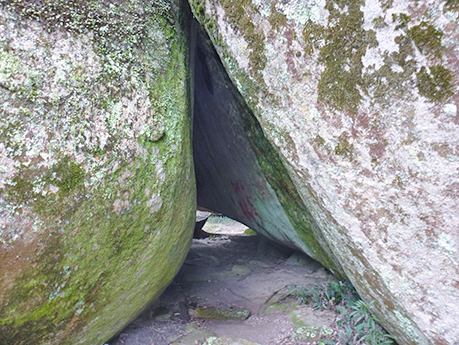
The Cave
Nevenka on the top of the Castle.
Plants clinging to the rock surface.
Gerry Clarke B.PED

